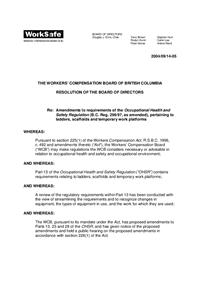BOD Decision - 2004/09/14-05 - Ladders, Scaffolds and Temporary Work Platforms requirements of the OHS Regulation
Complete Resolution
Part 13 of the Occupational Health and Safety Regulation contains requirements about ladders, scaffolds and temporary work platforms.
During its meeting on September 14, 2004, the Board of Directors approved amendments to Part 13. These amendments recognize changes in equipment and workplace practices and rationalize existing requirements. The amendments place greater reliance on standards, such as Canadian Standards Association standards, to allow flexibility to update applicable standards as the need arises.
The following amendments are new requirements that are intended to improve worker health and safety:
- Requiring an employer to keep records of inspection for swing stages.
- Requiring an additional structural inspection of vehicle-mounted elevating work platforms and self-propelled boom-supported elevating work platforms in the tenth year after the date of manufacture and every fifth year after that.
- Prohibiting the use of a secondary hoisting line on a crane where workers are on a work platform suspended from the crane.
Amendments to existing requirements have also been made to ensure an appropriate level of safety in the workplace:
- Raising the percentage of the rated capacity of a crane such that the weight of a suspended work platform cannot exceed 50%, instead of 25%, in recognition of current applicable standards.
- Removing the existing requirement to use a permanent powered platform if routine maintenance work is to be performed from a powered platform where the suspension height will be greater than 30 m.
In addition, the following changes to the proposal that went to public hearing were approved, in response to public hearing submissions and further review of the amendments:
- The new requirement for a structural inspection of vehicle-mounted elevating work platforms and self-propelled boom-supported elevating work platforms in the tenth year after the date of manufacture and every fifth year after that has been clarified to specify that the structural inspection should be conducted to ensure the platform still meets the standard to which the platform was manufactured.
- The requirement to restrict a movable work platform with a worker on it from being transported along the ground except when "minor adjustments" are made has been clarified to provide that the exception applies when only minor repositions are made to the platform. The change clarifies the intent of the requirement that only minor horizontal movement of the carrier vehicle is allowed.
- The requirement relating to lower limit travel devices on a hoist has been clarified. It provides that the devices must be used if a work platform is suspended over a structure that cannot safely support its weight or if other hazards exist below the platform (i.e., platform being lowered over water).
- The requirement pertaining to the use of a swing stage, boatswain's chair or portable powered platform in certain situations where there is a high risk of injury to the worker has been amended to require prior permission from the WCB. This change maintains the existing requirement. This revision takes into consideration other factors, such as wind, that play a significant role in affecting worker safety in these situations.
The proposal taken to public hearing included a new requirement for an employer to provide a personnel hoist capable of transporting an injured worker on a stretcher where a building under construction exceeds five floors. This proposal was not approved. The personnel hoist requirement will be brought forward for consideration as part of the priority setting process for the next phase of regulation review, with further discussion of its benefits in reducing musculoskeletal injuries.
The amendments come into effect on January 1, 2005.

